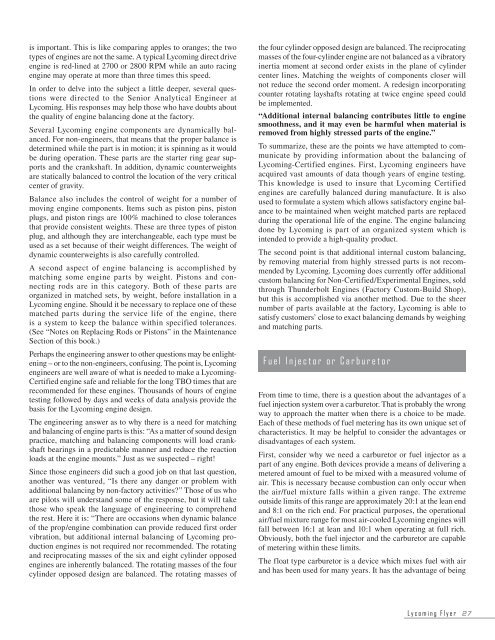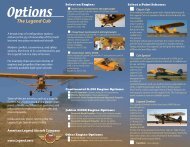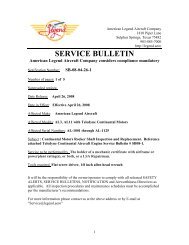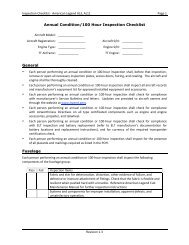Lycoming Flyer - Aircrafts sales, engines repair, spare parts
Lycoming Flyer - Aircrafts sales, engines repair, spare parts
Lycoming Flyer - Aircrafts sales, engines repair, spare parts
- No tags were found...
Create successful ePaper yourself
Turn your PDF publications into a flip-book with our unique Google optimized e-Paper software.
is important. This is like comparing apples to oranges; the twotypes of <strong>engines</strong> are not the same. A typical <strong>Lycoming</strong> direct driveengine is red-lined at 2700 or 2800 RPM while an auto racingengine may operate at more than three times this speed.In order to delve into the subject a little deeper, several questionswere directed to the Senior Analytical Engineer at<strong>Lycoming</strong>. His responses may help those who have doubts aboutthe quality of engine balancing done at the factory.Several <strong>Lycoming</strong> engine components are dynamically balanced.For non-engineers, that means that the proper balance isdetermined while the part is in motion; it is spinning as it wouldbe during operation. These <strong>parts</strong> are the starter ring gear supportsand the crankshaft. In addition, dynamic counterweightsare statically balanced to control the location of the very criticalcenter of gravity.Balance also includes the control of weight for a number ofmoving engine components. Items such as piston pins, pistonplugs, and piston rings are 100% machined to close tolerancesthat provide consistent weights. These are three types of pistonplug, and although they are interchangeable, each type must beused as a set because of their weight differences. The weight ofdynamic counterweights is also carefully controlled.A second aspect of engine balancing is accomplished bymatching some engine <strong>parts</strong> by weight. Pistons and connectingrods are in this category. Both of these <strong>parts</strong> areorganized in matched sets, by weight, before installation in a<strong>Lycoming</strong> engine. Should it be necessary to replace one of thesematched <strong>parts</strong> during the service life of the engine, thereis a system to keep the balance within specified tolerances.(See “Notes on Replacing Rods or Pistons” in the MaintenanceSection of this book.)Perhaps the engineering answer to other questions may be enlightening– or to the non-engineers, confusing. The point is, <strong>Lycoming</strong>engineers are well aware of what is needed to make a <strong>Lycoming</strong>-Certified engine safe and reliable for the long TBO times that arerecommended for these <strong>engines</strong>. Thousands of hours of enginetesting followed by days and weeks of data analysis provide thebasis for the <strong>Lycoming</strong> engine design.The engineering answer as to why there is a need for matchingand balancing of engine <strong>parts</strong> is this: “As a matter of sound designpractice, matching and balancing components will load crankshaftbearings in a predictable manner and reduce the reactionloads at the engine mounts.” Just as we suspected – right!Since those engineers did such a good job on that last question,another was ventured, “Is there any danger or problem withadditional balancing by non-factory activities?” Those of us whoare pilots will understand some of the response, but it will takethose who speak the language of engineering to comprehendthe rest. Here it is: “There are occasions when dynamic balanceof the prop/engine combination can provide reduced first ordervibration, but additional internal balancing of <strong>Lycoming</strong> production<strong>engines</strong> is not required nor recommended. The rotatingand reciprocating masses of the six and eight cylinder opposed<strong>engines</strong> are inherently balanced. The rotating masses of the fourcylinder opposed design are balanced. The rotating masses ofthe four cylinder opposed design are balanced. The reciprocatingmasses of the four-cylinder engine are not balanced as a vibratoryinertia moment at second order exists in the plane of cylindercenter lines. Matching the weights of components closer willnot reduce the second order moment. A redesign incorporatingcounter rotating layshafts rotating at twice engine speed couldbe implemented.“Additional internal balancing contributes little to <strong>engines</strong>moothness, and it may even be harmful when material isremoved from highly stressed <strong>parts</strong> of the engine.”To summarize, these are the points we have attempted to communicateby providing information about the balancing of<strong>Lycoming</strong>-Certified <strong>engines</strong>. First, <strong>Lycoming</strong> engineers haveacquired vast amounts of data though years of engine testing.This knowledge is used to insure that <strong>Lycoming</strong> Certified<strong>engines</strong> are carefully balanced during manufacture. It is alsoused to formulate a system which allows satisfactory engine balanceto be maintained when weight matched <strong>parts</strong> are replacedduring the operational life of the engine. The engine balancingdone by <strong>Lycoming</strong> is part of an organized system which isintended to provide a high-quality product.The second point is that additional internal custom balancing,by removing material from highly stressed <strong>parts</strong> is not recommendedby <strong>Lycoming</strong>. <strong>Lycoming</strong> does currently offer additionalcustom balancing for Non-Certified/Experimental Engines, soldthrough Thunderbolt Engines (Factory Custom-Build Shop),but this is accomplished via another method. Due to the sheernumber of <strong>parts</strong> available at the factory, <strong>Lycoming</strong> is able tosatisfy customers’ close to exact balancing demands by weighingand matching <strong>parts</strong>.From time to time, there is a question about the advantages of afuel injection system over a carburetor. That is probably the wrongway to approach the matter when there is a choice to be made.Each of these methods of fuel metering has its own unique set ofcharacteristics. It may be helpful to consider the advantages ordisadvantages of each system.First, consider why we need a carburetor or fuel injector as apart of any engine. Both devices provide a means of delivering ametered amount of fuel to be mixed with a measured volume ofair. This is necessary because combustion can only occur whenthe air/fuel mixture falls within a given range. The extremeoutside limits of this range are approximately 20:1 at the lean endand 8:1 on the rich end. For practical purposes, the operationalair/fuel mixture range for most air-cooled <strong>Lycoming</strong> <strong>engines</strong> willfall between 16:1 at lean and 10:1 when operating at full rich.Obviously, both the fuel injector and the carburetor are capableof metering within these limits.The float type carburetor is a device which mixes fuel with airand has been used for many years. It has the advantage of beingL y c o m i n g F l y e r 2 7









